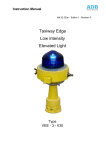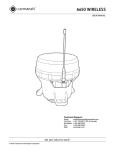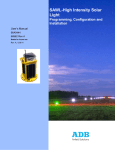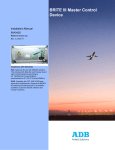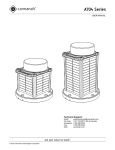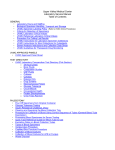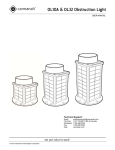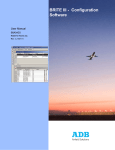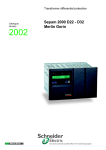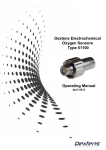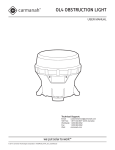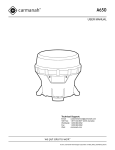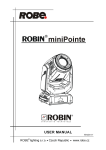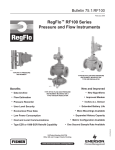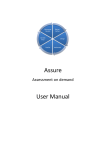Download SATO Wireless - ADB Airfield Solutions
Transcript
SATO Wireless Programming, Configuration and Installation User’s Manual 96A0443 66364 Rev A Retain for future use. Rev. A, 11/21/11 SATO Wireless 96A0443 Rev. A 11/21/11 Disclaimer Disclaimer Table of Contents This manual could contain technical inaccuracies or typographical errors. ADB Airfield Solutions reserves the right to revise this manual from time to time in the contents thereof without obligation of ADB Airfield Solutions to notify any person of such revision or change. Details and values given in this manual have been compiled with care. They are not binding, however, and ADB Airfield Solutions disclaims any liability for damages or detriments suffered as a result of reliance on the information given herein or the use of products, processes or equipment to which this manual refers. No warranty is made that the use of the information or of the products, processes or equipment to which this manual refers will not infringe any third party's patents or rights. Warranties Safety Products of ADB Airfield Solutions manufacturer are guaranteed against mechanical, electrical, and physical defects (excluding lamps) for a period of one year from the date of installation or a maximum of 18 months from date of shipment and are guaranteed to be merchantable and fit for the ordinary purposes for which such products are made. ADB Airfield Solutions will correct by repair or replacement, at its option, equipment or parts which fail because of mechanical, electrical or physical defects, provided that the goods have been properly handled and stored prior to installation, properly installed and properly operated after installation, and provided further that Buyer gives ADB Airfield Solutions written notice of such defects after delivery of the goods to Buyer. Refer to the Safety section for more information on Material Handling Precautions and Storage precautions that must be followed. ADB Airfield Solutions reserves the right to examine goods upon which a claim is made. Said goods must be presented in the same condition as when the defect therein was discovered. ADB Airfield Solutions furthers reserves the right to require the return of such goods to establish any claim. ADB Airfield Solutions’ obligation under this guarantee is limited to making repair or replacement within a reasonable time after receipt of such written notice and does not include any other costs such as the cost of removal of defective part, installation of repaired product, labor or consequential damages of any kind, the exclusive remedy being to require such new parts to be furnished. ADB Airfield Solutions’ liability under no circumstances will exceed the contract price of goods claimed to be defective. Any returns under this guarantee are to be on a transportation charges prepaid basis. For products not manufactured by, but sold by ADB Airfield Solutions, warranty is limited to that extended by the original manufacturer. This is ADB Airfield Solutions’ sole guarantee and warranty with respect to the goods; there are no express warranties or warranties of fitness for any particular purpose or any implied warranties of fitness for any particular purpose or any implied warranties other than those made expressly herein. All such warranties being expressly disclaimed. Introduction Installation Trademarks General notice: other product names used here are for identification purposes only and may be trademarks of their respective companies. Proprietary Information Operation Parts This information carrier contains proprietary information, which shall not be used for other purposes than those for which it has been released, nor be reproduced or disclosed to third parties without the prior written consent of ADB Airfield Solutions. No part of this publication may be reproduced, stored in a retrieval system, or transmitted in any form or by any means, mechanical, photocopy, recording, or otherwise, without the prior written permission of ADB Airfield Solutions. No patent liability is assumed with respect to the use of the information contained herein. Neither is any liability assumed for damages resulting from the use of the information contained herein. ADB Airfield Solutions shall not be liable to the purchaser of this product or third parties for damages, losses, costs, or expenses incurred by purchaser or third parties as a result of accident, misuse, or abuse of this product or unauthorized modifications, repairs, or alterations to this product. ADB Airfield Solutions shall not be liable against any damages arising from the use of any options or parts other than those designated as approved products. Copyright © 2010 by ADB Airfield Solutions. All rights reserved. Schematics ii © 2010 ADB Airfield Solutions All Rights Reserved 96A0443 Rev. A 11/21/11 SATO Wireless Disclaimer TABLE OF CONTENTS SATO Wireless .......................................................................................................... i Table of Contents 1.0: Safety ................................................................................................................... 1 Safety 1.1 :To use this equipment safely: .............................................................................. 1 1.1.1 :Additional Reference Materials: .................................................................. 1 1.1.2 :Safety & Usage ............................................................................................ 1 1.1.3 :Viewing Precautions .................................................................................... 1 1.1.4 :Battery Precautions ..................................................................................... 2 1.1.5 :Wireless Precautions ................................................................................... 2 1.1.6 :Warranty Disclaimer .................................................................................... 2 2.0: SATO Wireless .................................................................................................... 3 © 2010 ADB Airfield Solutions All Rights Reserved Schematics Parts Operation Installation Introduction 2.1 :About this manual ................................................................................................ 3 2.1.1 :How to work with the manual ....................................................................... 3 2.1.2 :Record of changes ...................................................................................... 3 2.1.3 :Icons used in the manual ............................................................................. 3 2.2 :Introduction .......................................................................................................... 4 2.2.1 :Compliance with Standards ......................................................................... 4 2.2.2 :Uses ............................................................................................................ 4 2.2.3 :Features ...................................................................................................... 4 2.2.4 :Wireless Hand-Held Controller .................................................................... 5 2.2.5 :Features ...................................................................................................... 5 2.2.6 :Photometric Data ......................................................................................... 5 2.2.7 :Spare Components ...................................................................................... 5 2.3 :Installation ............................................................................................................ 7 2.3.1 :Bird Deterrent .............................................................................................. 8 2.3.2 :Antenna ....................................................................................................... 9 2.3.3 :Location ..................................................................................................... 10 2.3.4 :Fastening ................................................................................................... 11 2.4 :Operation ........................................................................................................... 12 2.4.1 :Theory of Operation ................................................................................... 12 2.4.2 :Modes ........................................................................................................ 12 2.4.2.1 :Autonomous Mode ........................................................................... 12 2.4.2.2 :Temporary Mode ............................................................................. 12 2.4.2.3 :Standby Mode .................................................................................. 13 2.4.2.4 :Lights Off Mode ............................................................................... 13 2.4.2.5 :Emergency Mode ............................................................................. 13 2.4.2.6 :ARCAL Mode ................................................................................... 13 2.4.3 :Features .................................................................................................... 14 2.4.3.1 :On-Board User Interface................................................................... 14 2.4.3.2 :Switch ............................................................................................... 15 2.4.3.3 :Automatic Light Control .................................................................... 15 2.4.3.4 :Low Voltage Disconnect ................................................................... 16 2.4.3.5 :Diagnose .......................................................................................... 16 2.4.3.6 :Grouping .......................................................................................... 16 2.4.3.7 :Unique Code Sequence ................................................................... 16 2.4.3.8 :Factory Reset ................................................................................... 17 2.5 :Maintenance ....................................................................................................... 18 2.5.1 :Inspection .................................................................................................. 18 2.5.2 :Storage & Battery Charging ....................................................................... 18 2.5.3 :Battery Replacement ................................................................................. 19 2.5.4 :Recycling ................................................................................................... 24 2.6 :Troubleshooting ................................................................................................. 26 2.7 :Appendices ........................................................................................................ 27 iii SATO Wireless 96A0443 Rev. A 11/21/11 Disclaimer 2.7.1 :Glossary .....................................................................................................27 2.8 :Autonomous Mode .............................................................................................28 2.9 :Temporary Mode Activations ..............................................................................29 2.10 :Intensity ............................................................................................................30 2.11 :Wireless Regions ..............................................................................................31 2.12 :Specifications ...................................................................................................32 Document Date (12/2010) 36 Table of Contents Safety Introduction Installation Operation Parts Schematics iv © 2010 ADB Airfield Solutions All Rights Reserved 96A0443 Rev. A 11/21/11 This section contains general safety instructions for installing and using ADB Airfield Solutions equipment. Some safety instructions may not apply to the equipment in this manual. Task- and equipment-specific warnings are included in other sections of this manual where appropriate. 1.1 To use this equipment safely: Disclaimer 1.0 Safety SATO Wireless Safety WARNING 1.1.2 Safety & Usage Safety Installation Introduction Safety • • • • • NFPA 70B, Electrical Equipment Maintenance. NFPA 70E, Electrical Safety Requirements for Employee Workplaces. ANSI/NFPA 79, Electrical Standards for Metalworking Machine Tools. OSHA 29 CFR, Part 1910, Occupational Health and Safety Standards. National and local electrical codes and standards. Operation 1.1.1 Additional Reference Materials: Table of Contents Read installation instructions in their entirety before starting installation. • Refer to the FAA Advisory Circular AC 150/5340-26, Maintenance of Airport Visual Aids Facilities, for instructions on safety precautions. • Observe all safety regulations. To avoid injuries, always disconnect power before making any wiring connections or touching any parts. Refer to FAA Advisory Circular AC 150/5340-26. • Become familiar with the general safety instructions in this section of the manual before installing, operating, maintaining or repairing this equipment. • Read and carefully follow the instructions throughout this manual for performing specific tasks and working with specific equipment. • Make this manual available to personnel installing, operating, maintaining or repairing this equipment. • Follow all applicable safety procedures required by your company, industry standards and government or other regulatory agencies. • Install all electrical connections to local code. • Use only electrical wire of sufficient gauge and insulation to handle the rated current demand. All wiring must meet local codes. • Route electrical wiring along a protected path. Make sure they will not be damaged by moving equipment. • Protect components from damage, wear, and harsh environment conditions. • Allow ample room for maintenance, panel accessibility, and cover removal. • Protect components from damage, wear, and harsh environment conditions. • Allow ample room for maintenance, panel accessibility, and cover removal. • Protect equipment with safety devices as specified by applicable safety regulations. • If safety devices must be removed for installation, install them immediately after the work is completed and check them for proper functioning prior to returning power to the circuit. The following symbols indicate important safety warnings and precautions throughout this manual: Parts WARNING indicates that serious bodily harm or death may result from failure to adhere to the precautions. Schematics CAUTION indicates that damage to equipment may result if the instructions are not followed. NOTE suggests optimal conditions and provides additional information. WIRELESS features and functions that require a Handheld Controller. 1.1.3 Viewing Precautions © 2010 ADB Airfield Solutions All Rights Reserved Do not view an actively emitting infrared or visible light from the side of the light (close to or on beam) from a range of less than 4 ft. (1.2 m). 1 SATO Wireless To use this equipment safely: 96A0443 Rev. A 11/21/11 Disclaimer A safe limit for near-infrared viewing, established by the American Conference of Governmental and Industrial Hygienists (ACGIH), is 65 mW/in2 (10 mW/cm2) as the maximum exposure limit for viewing for up to 16 minutes. This power density can be produced at the lens surface when actively emitting infrared light. 1.1.4 Battery Precautions Table of Contents Use extreme caution when handling the light. This product is capable of generating enormous short-circuit currents. Remove all jewelry (bracelets, metal-strap watches, rings) before attempting to handle or remove the batteries. Charge your battery periodically. Permanent damage and reduced capacity will result if the battery is not correctly maintained. Safety The rate of battery self-discharge is very dependent upon temperature. The warmer the temperature, the faster the batteries will discharge. Introduction Installation To use this equipment Lights that have been stored will usually require a top-up charge before they are put into service. The most accurate battery health status reading is obtained when the unit has been in a dark location and in off mode for at least 24 hours. 1.1.5 Wireless Precautions Keep the Handheld Controller at a distance of at least 3 ft. (1 m) from the antennas of lights or other Handheld Controllers. It sends out a powerful radio signal that could damage sensitive receiver circuitry if operated at close range. Regulatory This device complies with Part 15 of the FCC Rules. Operation is subject to the following two conditions: 1. This device may not cause harmful interference, and Operation 2. This device must accept any interference received, including interference that may cause undesired operation. Parts This equipment has been tested and found to comply with the limits for a Class B digital device, pursuant to Part 15 of the FCC Rules. These limits are designed to provide reasonable protection against harmful interference in a residential installation. This equipment generates, uses, and can radiate radio frequency energy and, if not installed and used in accordance with the instruction manual, may cause harmful interference to radio communications; however, there is no guarantee that interference will not occur in a particular installation. If this equipment does cause harmful interference to radio or television reception, which can be determined by turning the equipment off or on, the user is encouraged to try to correct the interference by one or more of the following measures: Schematics • • • • Reorient or relocate the receiving antenna; Increase the separation between the equipment and receiver; Connect the equipment into an outlet on a circuit different from that to which the receiver is connected; Consult the dealer or an experienced radio/TV technician for help. This Class [B] digital apparatus complies with Canadian ICES-003. Cet appareil numérique de la classe [B] est conforme à la norme NMB-003 du Canada. 1.1.6 Warranty Disclaimer This manual will familiarize you with the features and operating standards of the product. Failure to comply with the use, storage, maintenance, or installation instructions detailed in this manual could void the user warranty. Changes or modifications not expressly approved by the party responsible for compliance could void the user’s authority to operate the equipment. Installation work must be done by a qualified person(s) in accordance with all application local codes and standards. 2 © 2010 ADB Airfield Solutions All Rights Reserved SATO Wireless SATO Wireless 2.0 SATO Wireless SATO Wireless Programming, Configuration and Installation. 2.1 About this manual The manual shows the information necessary to: • Program and Configure SATO Wireless Lights. 1. Become familiar with the structure and content. 2. Carry out the actions completely and in the given sequence. Table of Contents 2.1.1 How to work with the manual Disclaimer 96A0443 Rev. A 11/21/11 2.1.2 Record of changes Rev All A Description Checked Approved Date Released Manual For all WARNING symbols see the Safety section. Carefully read and observe all safety instructions in this manual, which alert you to safety hazards and conditions that may result in personal injury, death or property and equipment damage and are accompanied by the symbol shown below. Installation 2.1.3 Icons used in the manual SATO Wireless Safety Page Operation WARNING • Failure to observe a warning may result in personal injury, death or equipment damage. CAUTION Schematics Parts • Failure to observe a caution may result in equipment damage. © 2010 ADB Airfield Solutions All Rights Reserved 3 SATO Wireless Introduction 96A0443 Rev. A 11/21/11 Disclaimer 2.2 Introduction Ordering Code SATO-XXX10 Table of Contents Color 1 = Red 2 = White 3 = Blue 4 = Green 5 = Yellow Switching 0 = No switch 1 = Switch Safety Lens 1 = Clear Introduction Installation Wireless Communication 0 = Non-wireless 1 = Wireless Solar LED Aviation and Obstruction Lights are certified to: CSA, UL, CE, FCC, RoHS, ICAO, IP68/Nema6P, Explosive Atmosphere MIL-STD-810G, Method 511.5 2.2.2 Uses The SATO is a self-contained, high-performance, low-maintenance and easy-to-install solarpowered light source for permanent, temporary or emergency lighting in aviation and industrial environments. Applications include: taxiway edge lighting; apron edge lighting; emergency airfield and helipad lighting; construction barricade lighting on airfields; and obstruction lighting. 2.2.3 Features • Easy installation and relocation: no specialized work crew required, limited air traffic disruption and lights are immediately operational. The SATO can also be quickly relocated for temporary or emergency applications. • Self-contained and low maintenance: all components are incorporated within a compact, stand-alone unit. The SATO also features a replaceable battery pack that extends the service life beyond five years, reducing the total cost of ownership and resulting in significant cost savings. • Intelligent settings: the first solar product to incorporate intelligent deployment location settings that allow the SATO to tune its intensity to its location, protecting itself against improper configuration. • Unprecedented reliability: microprocessor Energy Management System (EMS) monitors and adapts the light to environmental conditions for consistent operation and long life under the toughest conditions. • Designed and tested to toughest industrial standards: MIL-STD-202G: Humidity, Immersion, Vibration, Shock; MIL-STD-810F: Solar radiation, Salt Fog; EN 60945: ESD, EMI, EMC; IP68; L70. The SATO is acceptable for barricade and construction applications at Commercial Part 139 Airports under FAA Advisory Circular AC 150/53702E. The SATO Blue is compliant with the requirements of ICAO Annex 14, Volume 1, Fourth Edition dated July 2004 (ETL Certified). • User friendly: easy configuration and programming options including: on-board user interface, infrared remote and Device Manager software through USB connection. Optional programmable external switch. Optional wireless control system offering secure 900 MHz wireless control from ground or air. • Green solution: a clean, renewable and reliable energy source with the lightest environmental footprint. The SATO features recyclable batteries and is entirely RoHS compliant. • • Up to 10 cd of intensity (steady-on, green, equatorial). Operation 2.2.1 Compliance with Standards Parts Schematics 4 Replaceable and recyclable battery pack. © 2010 ADB Airfield Solutions All Rights Reserved SATO Wireless Introduction Dusk-to-Dawn operation. Optional external switch. Intelligent deployment location settings protect against improper configuration. One or more wireless SATO lights can be remotely operated from the ground or air with a handheld wireless controller: secure radio transceiver, with antenna and keypad. Table of Contents 2.2.4 Wireless Hand-Held Controller Intuitive on-board user interface. Disclaimer • • • • Battery Replacement Kit for Wireless Hand-held Controller 2.2.5 Features • • • • • • • • Safety Wireless Hand-Held Controller Ordering Code Part # SAWL-HC Part # 48247 Water-resistant keypad and LED indicators. Utilizes a secure wireless RF signal. Control range of up to 2.5 miles. Meets MIL-SPEC-810E environmental requirements. 24-hour operation on a single charge. Rechargeable lithium-ion battery (included); recharges via an AC/DC wall plug (included). Compatible with stand-alone aviation band VHF receiver. Comes complete in a custom Pelican™ case. Schematics Parts Operation 2.2.6 Photometric Data Installation Introduction 96A0443 Rev. A 11/21/11 NOTE: Intensity dependent on location. Based on equatorial location of 12-hour night duration and steady-on (001) flash code. For colored graph, see the ADB website. 2.2.7 Spare Components For a complete list of solar aviation light accessories, including mounting equipment, see Catalog Sheet 3017. © 2010 ADB Airfield Solutions All Rights Reserved 5 SATO Wireless Introduction 96A0443 Rev. A 11/21/11 Disclaimer Equipment Data Table of Contents Solar Panel- High-efficiency cells with bypass and blocking diode function. Maximum power point tracking (MPPT) for optimal energy collection. Battery Tool-less replaceable and recyclable best-in-class battery pack with extreme temperature range. Battery status feedback of Good, Charge or Bad (Replace). Light Source High power LED. Color-specific temperature corrected LED drivers provide conisitent intensity under all operating conditions. Intensity 10 cd intensity, steady-on (see photometric plot on reverse). 18 cd peak intensity, flashing, 12.5% duty cycle (Red LEDs). Flash Patterns 256+ Construction Premium grade UV resistant, polycarbonate/ polysiloxane co-polymer body and lens material. Double O-ring sealing with waterproof vent. Safety Colors Blue, Red, Yellow, Green and White. ICAO and SAE25050 (FAA) compliant chromaticity. Ambient -45 ºF to +124 ºF (-43 ºC to +51 ºC) Operating The SATO will function up to +190 ºF (+88 ºC) Introduction Installation Temperature internal and surface temperatures. Storage -45 ºF to +176 ºF (-43 ºC to +80 ºC) Temperature Color Indicator Yes, FAA Engineering Brief No. 67 compliant. Weight 3.5 lb (1.58 kg) Wind Loading 400 mph (180 m/s) Automatic Light When enabled, ALC will dynamically reduce Control (ALC) brightness in response to unusually low amounts of sunlight to ensure continued operation. Wireless Range Frequency Operation Control, On-demand Mode 2.5 miles minimum with 1 W wireless hand-held controller 900 MHz ISM Band (902 – 928 MHz), FHSS Seamless integration with existing ADB wireless solar products. Up to 8 independent groups. Parts Schematics 6 © 2010 ADB Airfield Solutions All Rights Reserved 96A0443 Rev. A 11/21/11 The SATO Wireless includes: SATO Wireless Antenna Bird deterrent Quick Start Guide Installation Installation Safety Table of Contents • • • • Disclaimer 2.3 Installation SATO Wireless Installation Schematics Parts Operation The manual (this document) is shipped independently. It is available for download from www.adb-airfield.com © 2010 ADB Airfield Solutions All Rights Reserved 7 SATO Wireless Installation Disclaimer 2.3.1 Bird Deterrent 96A0443 Rev. A 11/21/11 The SATO Wireless can have up to 2 bird deterrents. Install the deterrents before fastening the light down. Do not install a bird deterrent in the mounting foot directly below the antenna. Table of Contents Safety Installation Installation Operation Parts Schematics 8 © 2010 ADB Airfield Solutions All Rights Reserved 96A0443 Rev. A 11/21/11 Disclaimer Grip the antenna by its metal base and hand-tighten it onto the antenna connector. Installation Safety Table of Contents 2.3.2 Antenna SATO Wireless Installation Handheld Controller antenna is parallel to the light’s antenna • • • Elevate the Handheld Controller’s antenna Parts Operation • Installation The effective range of the wireless control system is 2.5 miles (4 km). Wireless range is greatly affected by use and location. To achieve the best wireless range: Schematics Ensure surrounding grass and foliage is trim Clear line-of-sight between antennas © 2010 ADB Airfield Solutions All Rights Reserved 9 SATO Wireless Installation Disclaimer 2.3.3 Location 96A0443 Rev. A 11/21/11 Year-round, unrestricted solar exposure is critical to long-term performance. Shade dramatically reduces the ability of the light to charge its battery. Table of Contents Year-round sun: During the winter, the sun is lower on the horizon. Because the angle of the sun changes with the seasons, you must be aware that obstructions such as trees, buildings, and mountains that do not shade the solar panel during the summer may shade it during the winter. Safety Installation Installation Operation Cooler is better: The battery lasts longest if you can minimize its exposure to high temperatures. Choose a location that is away from hot, dark colored surfaces like asphalt or black steel plate. Mounting kits are available that elevate the light and can help reduce the temperature of the battery. Parts Flat: Ensure the mounting surface is flat and level. The surfaces in contact with the 3 mounting feet must be flat to within 0.12 in. (3 mm) of one another. Schematics 10 © 2010 ADB Airfield Solutions All Rights Reserved 96A0443 Rev. A 11/21/11 Disclaimer The SATO Wireless has 3 mounting feet with holes for 0.25 in. (6 mm) fasteners. The mounting holes have a bolt circle of 5.9 in. (150 mm). Fasteners are not included but are available as kits. Schematics Parts Operation Installation Installation Safety Table of Contents 2.3.4 Fastening SATO Wireless Installation © 2010 ADB Airfield Solutions All Rights Reserved 11 SATO Wireless Operation 96A0443 Rev. A 11/21/11 Disclaimer 2.4 Operation 2.4.1 Theory of Operation During daylight, the solar panel charges the battery using the Energy Management System (EMS). The capacity of the battery ensures that even with poor levels of sunlight over an extended period, the light has enough reserve power to continue to perform reliably. Table of Contents Stored battery energy is then available to power the output LED in one of several modes. These modes are selected using the Handheld Controller. The most commonly used are Autonomous and Temporary Modes. The Handheld Controller contains a 900 MHz radio that transmits commands to a receiving radio inside the SATO Wireless. For Handheld Controller button sequences for the below modes and features, see the Handheld Controller manual. 2.4.2 Modes Safety 2.4.2.1 Autonomous Mode In Autonom ous Mode, the output LED turns on from dusk-to-dawn and turns off during daylight. The change from dusk-to-dawn or dawn-to-dusk is known as a transition. A built-in ambient brightness sensor detects transitions. Operation NOTE: Autonomous Mode setting is determined by a map in the Appendices. Correct setting is important to ensure sustainable, year-round operation. The Autonomous Mode setting is selected via the Handheld Controller: Installation Setting Intensity Output LED Flashing Active Auto Low Low Visible No Dusk-to-dawn Operation AUTO MED Medium Visible No Dusk-to-dawn AUTO HIGH High Visible No Dusk-to-dawn Auto Low IR Low Infrared No Dusk-to-dawn AUTO MED IR Medium Infrared No Dusk-to-dawn AUTO HIGH IR High Infrared No Dusk-to-dawn Auto Low flash Low Visible 0.25 sec. on, 0.75 sec. off Dusk-to-dawn AUTO MED flash Medium Visible 0.25 sec. on, 0.75 sec. off Dusk-to-dawn AUTO HIGH flash High Visible 0.25 sec. on, 0.75 sec. off Dusk-to-dawn Parts Auto Low IR flash Low Infrared 0.25 sec. on, 0.75 sec. off Dusk-to-dawn AUTO MED IR flash Medium Infrared 0.25 sec. on, 0.75 sec. off Dusk-to-dawn AUTO HIGH IR flash High Infrared 0.25 sec. on, 0.75 sec. off Dusk-to-dawn Factory default is AUTO LOW, visible LED, non-flashing. Schematics 2.4.2.2 Temporary Mode In Temporary Mode, the output LED is directly controlled by the Handheld Controller. A Temporary Mode activation interrupts other modes and ignores transitions. This activation lasts for 15 min. and then the light reverts to its previous Autonomous Mode. NOTE: Maximum number Temporary Mode activations per day is determined by a map in the Appendices. It is possible to use more Temporary Mode activations per day. The battery will then require more than 1 day of solar energy to fully charge. The Temporary Mode setting is selected via the Handheld Controller: 12 Setting Intensity Output LED Flashing Active temp Low Low Visible No 15 min. TEMP MED Medium Visible No 15 min. TEMP HIGH High Visible No 15 min. © 2010 ADB Airfield Solutions All Rights Reserved Infrared No 15 min. Infrared No 15 min. temp HIGH IR High Infrared No 15 min. temp Low flash Low Visible 0.25 sec. on, 0.75 sec. off 15 min. temp MED flash Medium Visible 0.25 sec. on, 0.75 sec. off 15 min. temp HIGH flash High Visible 0.25 sec. on, 0.75 sec. off 15 min. temp Low IR flash Low Infrared 0.25 sec. on, 0.75 sec. off 15 min. temp MED IR flash Medium Infrared 0.25 sec. on, 0.75 sec. off 15 min. temp HIGH IR flash High Infrared 0.25 sec. on, 0.75 sec. off 15 min. Table of Contents Low Medium Standby Mode turns off the output LED and waits for the next transition. After a transition, the light enters its previous Autonomous Mode. 2.4.2.4 Lights Off Mode Lights Off Mode turns off the output LED indefinitely until it receives a command to turn them on. Lights Off Mode is entered via the Handheld Controller and is different than sliding the switch to OFF. 2.4.2.5 Emergency Mode Emergency Mode sets all lights in all groups to emergency flash. Emergency flash is TEMP HIGH FLASH. After 15 min., the lights revert to their previous Autonomous modes. 2.4.2.6 ARCAL Mode The Aircraft Radio Control of Aerodrome Lighting (ARCAL) feature works in conjunction with an ARCAL VHF receiver to allow aircraft pilots to control the airfield lights. Schematics Parts Operation Installation 2.4.2.3 Standby Mode Safety temp Low IR temp MED IR Disclaimer SATO Wireless Operation Operation 96A0443 Rev. A 11/21/11 © 2010 ADB Airfield Solutions All Rights Reserved 13 SATO Wireless Operation 96A0443 Rev. A 11/21/11 Disclaimer 2.4.3 Features 2.4.3.1 On-Board User Interface The On-Board User Interface (OBUI) is viewable through the bottom cover. Slide the switch ON or press a button on the OBUI to turn on the display. The OBUI has no user editable parameters and provides read-only feedback: Table of Contents Good, deploy the light What is the battery’s state of charge? Charge the battery before deploying Safety VD is entered; charge the battery before deploying Bad battery needs replacing Operation Ready to receive wireless commands Is the wireless system on? Installation Will not receive wireless commands Radio failure Operation Parts Are the infrared output LEDs on? What group ID is the light part of? Is Universal Code Sequence on? System version? Schematics 14 © 2010 ADB Airfield Solutions All Rights Reserved 96A0443 Rev. A 11/21/11 The switch must be ON ( I ) to respond to Handheld Controller commands: Light enters its last mode Operation Safety Table of Contents • Disclaimer 2.4.3.2 Switch SATO Wireless Operation Switch the light OFF ( O ) to ship or store it: Will not respond to wireless control and will not be able to turn on its output LEDs Stores the last mode Installation Sunlight will continue to charge the battery Does not turn itself off after 24 hours of darkness 2.4.3.3 Automatic Light Control Schematics Parts Operation • • • • • Automatic Light Control (ALC) is a patented algorithm that matches the light’s energy consumption to its energy storage. As the battery state of charge diminishes, ALC decreases the output LED intensity. ALC has 9 intensity steps until finally entering LVD. The ALC step depends on the battery state of charge. This ensures the light will continue to operate through periods of poor sunlight. ALC is enabled in all Autonomous Modes. ALC is disabled in all Temporary Modes. © 2010 ADB Airfield Solutions All Rights Reserved 15 SATO Wireless Operation Disclaimer 2.4.3.4 Low Voltage Disconnect 96A0443 Rev. A 11/21/11 Low Voltage Disconnect (LVD) protects the battery from being discharged to levels low enough to cause permanent damage. When LVD is entered: Table of Contents • • • • • 2.4.3.5 Diagnose Radio and output LED are disabled Output LED flashes 0.1 sec. every 60 sec. to let the user know the light needs attention Battery continues charging When the battery state of charge reaches an acceptable level, LVD is exited. LVD is enabled in all Modes. The battery state of charge and radio health can be queried via the Handheld Controller using its Diagnose function. Diagnose is disabled when LVD is entered. Safety 2.4.3.6 Grouping Grouping allows independent control of different subsets of lights on an airfield: Operation • • • • • There are 8 groups, numbered 1 through 8 Each light can be assigned to only one group Handheld controller can control multiple groups at a time A light can be reassigned to another group as required When adding a light to a group, the Handheld Controller re-sends the last mode to everyone in that group In order to configure the group of a light: Installation 1. Light must be ON for at least 10 sec., then slide the switch OFF and then ON within 10 sec. 2. This quick ON-OFF-ON instructs the light to receive grouping 3. configurations from the Handheld Controller for 5 min. 4. Grouping configuration is sent from Handheld Controller 5. After successfully receiving a grouping configuration Operation 6. , the light flashes for 7 sec. 7. Factory default is group 1. 2.4.3.7 Unique Code Sequence Unique Code Sequence (UCS) allows one or more Handheld Controllers to be uniquely associated to one or more lights. When UCS is enabled, the Handheld Controller sends a code with each radio transmission. Only lights configured to accept that particular code will respond to the transmission. The benefits are: Parts Independence Security nearby installations of lights can be operated independently by different Handheld Controllers without interference it is not possible for another Handheld Controller to interrupt airfield operation Schematics The Handheld Controller cannot control UCS configured and non-UCS configured lights at the same time. For security, the user has to manually interact with the light for UCS configuration: 1. Light must be ON for at least 10 sec., then slide the switch OFF and then ON within 10 sec. 2. This quick ON-OFF-ON 3. instructs the light to receive UCS configurations from the Handheld Controller for 5 min. 4. UCS configuration is sent from Handheld Controller 5. After successfully receiving a UCS configuration, the light flashes for 7 sec. 6. Factory default is UCS disabled. 16 © 2010 ADB Airfield Solutions All Rights Reserved 96A0443 Rev. A 11/21/11 Factory Reset sets the light back to a known state: • • • Disclaimer 2.4.3.8 Factory Reset SATO Wireless Operation AUTO LOW visible LED, non-flashing Group 1 UCS off Remove bottom cover Press & hold SET for 2 sec. OBUI displays Schematics Parts Operation Installation Operation Safety • • • • Table of Contents To perform a Factory Reset: © 2010 ADB Airfield Solutions All Rights Reserved 17 SATO Wireless Maintenance 96A0443 Rev. A 11/21/11 Disclaimer 2.5 Maintenance 2.5.1 Inspection Table of Contents 2.5.2 Storage & Battery Charging Although the SATO Wireless is maintenance-free, significant performance gains can be made with clean solar panels and lenses: • Clean the solar panels monthly. Use water and a soft sponge or cloth. A mild nonabrasive cleanser can be used for more stubborn residue. Rinse well. • Clean solar panels and lenses more frequently during drier months, as they may become covered in dust more quickly. A pressure washer is not recommended. • Visual inspection – check the exterior for cracks, missing or broken hardware or other potential problems. When storing the light, it is important to maintain the battery: Safety • • • Switch the light OFF or disconnect the battery Store in a cool location Check the battery state of charge every 1 month NOTE: Do not use the Lights Off Mode for storing the light. The radio is still active in this mode and may receive wireless commands. Maintenance If the OBUI indicates or , the battery requires charging. Charge the battery fully until the OBUI indicates . The battery can be charged by placing the light in sunlight or under an incandescent light bulb. Installation Operation Parts Schematics 18 © 2010 ADB Airfield Solutions All Rights Reserved SATO Wireless Maintenance 2.5.3 Battery Replacement Maintenance Safety Table of Contents The battery may also be charged using the available alternating current (AC) plug-in battery charger: Disclaimer 96A0443 Rev. A 11/21/11 If the OBUI indicates , the battery state of charge is bad. The battery is permanently damaged and needs to be replaced: Parts Operation Installation 1. Turn the light upside down on a soft surface to avoid scratching Schematics 2. Turn the locking screw counterclockwise to allow the locking tab to clear. Do not completely remove the locking screw 3. Turn the bottom cover counterclockwise until it stops. An available bottom cover tool assists in the rotation and insertion of the bottom cover. © 2010 ADB Airfield Solutions All Rights Reserved 19 SATO Wireless Maintenance 96A0443 Rev. A 11/21/11 Disclaimer Table of Contents Safety Maintenance Installation 4. Push up on the locking tab to lift the bottom cover out Operation Parts Schematics 5. Press down on the 20 © 2010 ADB Airfield Solutions All Rights Reserved SATO Wireless Maintenance Safety Table of Contents 6. connector latch and gently pull on the connector body to disconnect. Do not pull by the wires. Disclaimer 96A0443 Rev. A 11/21/11 Schematics Parts Operation Installation Maintenance 7. Unhook the battery strap from the tab and pull up on the battery strap © 2010 ADB Airfield Solutions All Rights Reserved 21 SATO Wireless Maintenance 96A0443 Rev. A 11/21/11 Disclaimer 8. Stretch the battery strap out of the way and pull the battery out by its ribbon, being careful not to damage any wires Table of Contents Safety Maintenance Installation Operation Parts Schematics 22 © 2010 ADB Airfield Solutions All Rights Reserved 96A0443 Rev. A 11/21/11 SATO Wireless Maintenance Disclaimer Installing a battery is similar to the above steps: 1. Stretch the battery strap out of the way and gently insert battery 2. Pull the battery strap over the battery and hook onto the tab a. For a used battery, plug in the battery connector. Table of Contents b. For a new battery, hold down the SET button and plug in the battery connector. Continue to hold SET until is displayed and then release. This resets the battery health monitor so that the light knows this is a new battery. 4. If the bottom cover was difficult to remove, apply a thin coat of silicone o-ring lubricant to the o-rings before installation. Schematics Parts Operation 5. Align the bottom cover locking tab with the small angled wall in the chassis Installation Maintenance Safety 3. Ensure the bottom cover o-rings and the inside surfaces of the light are clean. © 2010 ADB Airfield Solutions All Rights Reserved 23 SATO Wireless Maintenance 96A0443 Rev. A 11/21/11 Disclaimer 6. Turn the bottom cover clockwise while pressing down. Turn until the locking tab aligns with the locking screw. An available bottom cover tool assists in the rotation and insertion of the bottom cover. Table of Contents Safety Maintenance Installation Operation 7. Turn the locking screw clockwise to lock the bottom cover in the installed position. Parts Schematics 2.5.4 Recycling 24 This product required the extraction and use of natural resources. It may contain substances that could be harmful to the environment or human health if improperly handled at the product’s end of life. In order to avoid release of such substances into the environment and to reduce the use of natural resources, we encourage you to recycle the product in an appropriate way that will ensure most of the materials are reused or recycled appropriately. Check your local municipality for electronics recyclers. © 2010 ADB Airfield Solutions All Rights Reserved The symbol indicates that this product complies with the European Union’s requirements according to Directive 2002/96/EC on waste electrical and electronic equipment (WEEE). Schematics Parts Operation Installation Maintenance Safety The battery is a rechargeable lead-acid AGM battery. Consult your local laws for information on recycling. Disclaimer SATO Wireless Maintenance Table of Contents 96A0443 Rev. A 11/21/11 © 2010 ADB Airfield Solutions All Rights Reserved 25 SATO Wireless Troubleshooting 96A0443 Rev. A 11/21/11 Disclaimer 2.6 Troubleshooting Symptom Cause LVD is entered Table of Contents Output LED is off and unresponsive to wireless control Safety Output LED is off in Autonomous Mode Troubleshooting Installation Output LED is on, but unresponsive to wireless control Operation Output LED flashes once every minute. Solution Charge the battery Battery is bad Replace the battery Battery is not connected Check that the battery connector is fully inserted Switch is OFF Slide switch to ON Mismatched groups Ensure the Handheld Controller’s and light’s group match Infrared LEDs are on De-select the IR button on the Handheld Controller; send a visible output command UCS is enabled Ensure the Handheld Controller’s and light’s UCS match or turn off UCS Radio failure Call Customer Service Daylight; ambient brightness is above 500 lux Darken the entire light and wait 20 sec. for the light to turn on Nearby lights are illuminating the ambient brightness sensor Increase distance between lights, turn off unneeded lights, or shield lights Antenna not installed Ensure the light’s antenna is properly installed Handheld Controller problem Check Handheld Controller battery, PIN status, and Passthrough Mismatched groups Ensure the Handheld Controller’s and light’s group match UCS is enabled Ensure the Handheld Controller’s and light’s UCS match or disable UCS Radio failure Call Customer Service LVD is entered Charge the battery Battery is bad Replace the battery Parts Schematics 26 © 2010 ADB Airfield Solutions All Rights Reserved 96A0443 Rev. A 11/21/11 SATO Wireless Appendices Disclaimer 2.7 Appendices American Conference of Governmental and Industrial Hygienists AGM Absorbed Glass Matt ALC Automatic Light Control ARCAL Aircraft Radio Control of Aerodrome Lighting DC Direct Current EMS Energy Management System FAA Federal Aviation Administration FCC Federal Communications Commission ICAO International Civil Aviation Organization ICES Industry Canada Equipment Standard IR Infrared ISM Industrial, Scientific and Medical LED Light Emitting Diode LVD Low Voltage Disconnect NVG Night Vision Goggle OBUI On-Board User Interface RoHS Restriction on Hazardous Substances Universal Code Sequence WEEE Waste Electrical and Electronic Equipment Schematics Parts Operation UCS Safety Alternating Current ACGIH Installation Appendices AC Table of Contents 2.7.1 Glossary © 2010 ADB Airfield Solutions All Rights Reserved 27 SATO Wireless Autonomous Mode Disclaimer 2.8 Autonomous Mode 96A0443 Rev. A 11/21/11 The recommended Autonomous Mode setting is determined by the amount of solar energy, day length, and ambient temperature at a given location. • • • Autonomous Mode operates dusk-to-dawn Visible and IR output LEDs consume a similar amount of energy Flashing consumes less energy since the LEDs are on for less time Table of Contents Autonomy is the number of days that the light can operate without any solar energy. It is determined by the Autonomous Mode and the battery size. Several days of autonomy is required to ensure continued functionality during periods of poor weather. Region Autonomous Mode Autonomy Safety Autonomous Mode Blue AUTO LOW AUTO MED FLASH AUTO LOW IR AUTO MED IR FLASH 8 days min. Yellow AUTO MED AUTO HI FLASH AUTO MED IR AUTO HI IR FLASH 7 days min. Red AUTO HI AUTO HI FLASH AUTO HI IR AUTO HI IR FLASH 6 days min. Grey Not recommended for installation Installation Operation Parts Schematics 28 © 2010 ADB Airfield Solutions All Rights Reserved The maximum number of Temporary Mode activations per day is determined by the amount of solar energy, day length, and ambient temperature at a given location. • • • Each activation is 15 min. of LED output. Visible and IR output LEDs consume a similar amount of energy Flashing consumes less energy since the LEDs are on for less time NOTE: It is possible to use more Temporary Mode activations per day. The battery will then require more than 1 day of solar energy to fully charge. Disclaimer 2.9 Temporary Mode Activations SATO Wireless Temporary Mode Activations Table of Contents 96A0443 Rev. A 11/21/11 TEMP MED or TEMP MED IR TEMP HIGH or TEMP HIGH IR TEMP LOW FLASH or TEMP LOW IR FLASH TEMP MED FLASH or TEMP MED IR FLASH TEMP HIGH FLASH or TEMP HIGH IR FLASH Blue 4 3 2 15 11 8 Yellow 15 11 8 62 42 32 Red 27 18 14 108 74 56 Not recommended for installation Schematics Parts Operation Installation Grey Temporary Mode Activations Region TEMP LOW or TEMP LOW IR Safety Temporary Mode Activations, daily max. © 2010 ADB Airfield Solutions All Rights Reserved 29 SATO Wireless Intensity 96A0443 Rev. A 11/21/11 Disclaimer 2.10 Intensity The SATO Wireless is designed to output light at high vertical angles to meet taxiway, obstruction, and helipad applications. The output is omnidirectional in the horizontal plane. The average vertical divergence is plotted below for all colors in TEMP HIGH mode. The visible output unit is candela (cd) and the infrared output unit is milliwatts per steradian (mW/sr) at 870 nm peak wavelength. Table of Contents Peak Intensity Output AUTO LOW or AUTO LOW FLASH AUTO MED or AUTO MED FLASH AUTO HIGH or AUTO HIGH FLASH TEMP LOW or TEMP LOW FLASH TEMP MED or TEMP MED FLASH TEMP HIGH or TEMP HIGH FLASH Safety Blue 0.2 0.6 1.0 1.4 2.1 2.8 Red 0.5 1.6 2.7 4.0 5.9 7.8 10.0 Intensity White 0.7 2.1 3.4 5.2 7.6 Yellow 0.5 1.4 2.3 3.5 5.2 6.8 Green 0.4 1.3 2.2 3.4 4.9 6.5 Infrared 0.4 1.1 1.8 2.7 3.9 5.2 Installation Operation Parts Schematics 30 © 2010 ADB Airfield Solutions All Rights Reserved The radio in this light is only approved for installation in ISM Region 2, 900 MHz (902 – 928 MHz). Schematics Parts Operation Installation Wireless Regions Safety Table of Contents 2.11 Wireless Regions SATO Wireless Wireless Regions Disclaimer 96A0443 Rev. A 11/21/11 © 2010 ADB Airfield Solutions All Rights Reserved 31 SATO Wireless Specifications 96A0443 Rev. A 11/21/11 Disclaimer 2.12 Specifications Physical 5.91 in. (150 mm) 3-hole bolting circle Mounting 0.25 in. (6 mm) hardware Table of Contents Over-torque resistant Polycarbonate / polysiloxane alloy Chassis Double o-ring sealing Waterproof, vented battery compartment Safety Height 10.9 in. (276 mm) Width 7.4 in. (188 mm) Weight 3.5 lb. (1.6 kg) Operating Temperature Storage Temperature -45 to 124 °F (-43 to 51 °C) ambient -45 to 190 °F (-43 to 88 °C) internal -45 to 176 °F (-43 to 80 °C) ambient Specifications Optical Light Source Intensity Installation Chromaticity High-power visible LED Infrared LEDs, NVG-compatible See plots in Appendices Visible: - ICAO and FAA (SAE 25050) blue, red, white, yellow, and red Infrared: - 870 – 890 nm peak wavelength Operation Flash Pattern 0.25 sec. on, 0.75 sec. off Ambient Light Sensing 445 – 505 lux Automatic Light Control (ALC) Yes, ALC will reduce output intensity in response to unusually low amounts of sunlight to ensure continued operation Color Indicator Yes, FAA Eng. Brief 67 compliant Energy Collection Control Solar Panel Parts Air Gap between Solar Panel and Lens Intelligent, microprocessor Energy Management System (EMS) High-efficiency cells w/ bypass diodes Blocking diode function No, an air gap is undesirable because it refracts sunlight and decreases the amount of solar energy collected Maximum Power Point Tracking (MPPT) collects the most energy under all sunlight conditions Battery Charger Temperature-compensated Schematics Reverse polarity protection Pure lead, valve-regulated lead-acid (VRLA) Battery Absorbed glass mat (AGM) w/ metal case Tool-less replacement Recyclable User Interface On-board User Interface Yes, LED display Battery state of charge, wireless, infrared, group, UCS, info. Datalogger Yes Battery State of Health Yes Ability to Connect to Computer Yes, mini-USB 32 © 2010 ADB Airfield Solutions All Rights Reserved 96A0443 Rev. A 11/21/11 SATO Wireless Specifications Disclaimer Wireless Control 902 – 928 MHz FHSS Radio Up to 2.5 miles (4 km) range Replaceable antenna Visible, infrared, steady-on, and flashing settings Table of Contents Light Control Autonomous, Temporary, Standby, Lights Off, and Emergency Modes Diagnostics Yes Grouping Yes, up to 8 Universal Code Sequence (UCS) Yes ARCAL Control Yes ICAO Photometrics Safety Standards and Testing Annex 14, 5th Ed. 2009blue taxiway edge AC 150/5345-46C - L-861T blue taxiway edge AC 150/5345-50B - L-863 blue, yellow, green, red portable AC 150/5345-46C - L-860E red-red Specifications FAA Photometrics AC 150/5370-2E - barricades & construction UL 1104 Part 23 EN 60945, Part 8.7 Vibration, 3 – 60 Hz MIL-STD-202G, Method 201A, 10 – 55 Hz Installation Vibration MIL-STD-202G, Method 204, Test Condition B, 10 – 55 Hz UL 1104 Part 27.4 EN 60945 Part 8.6 Drop Shock MIL-STD-202G, Method 213B, Test Condition G Operation MIL-STD-202G, Method 213B, Test Condition H MIL-STD-810F, Method 516.5, Procedure IV Ingress Salt Fog Chemical Resistance 400 mph (179 m/s) EN 60529, IP 68 MIL-STD-202G, Method 104A, Test Condition B MIL-STD-810G, Method 509.4 ASTM B117-73 (1979) Parts Wind Loading MIL-STD-810G, Method 504, Procedure II EN 61547 EN 61000-4-2 - up to ± 16 kV air and contact discharge Schematics Electrostatic Discharge (ESD) FAA-STD-019E - compliant for ESD FCC Part 15 - emissions & immunity ICES-003 - emissions & immunity Electromagnetic Interference (EMI) & Electromagnetic Compatibility (EMC) EN 61000-6-3 - emissions EN 61000-6-4 - emissions EN 61000-6-2 - immunity EN 61000-4-3 - immunity Mounting Fastener Over-torque Tested to withstand up to 65 ft.-lb. (88 N-m) LED Lumen Maintenance IES LM-80 Battery Life IEC 61427 Humidity / Damp Heat Solar Radiation MIL-STD-810G, Method 507.5 MIL-STD-202G MIL-STD-810G, Method 505.5, Procedure II, climate cycle A2 © 2010 ADB Airfield Solutions All Rights Reserved 33 SATO Wireless Specifications 96A0443 Rev. A 11/21/11 Disclaimer RoHS Yes Patents US 5 782 552, 6 013 985, 6 573 659 and other US and international patents apply Table of Contents Safety Specifications Installation Operation Parts Schematics 34 © 2010 ADB Airfield Solutions All Rights Reserved SATO Wireless User’s Manual Registered office: France ADB Airfield Solutions LLC Phone: +33 (1) 4922 9250 ADB Fax: +33 (1) 4922 9255 Unit 44, Business Innovation Centre 977 Gahanna Parkway Binley Business Park Columbus, OH 43230 ADB Airfield Solutions GmbH & Co. KG Harry Weston Road USA Von-der-Tannstr. 31 Coventry, CV3 2TX Phone: +1 (614) 8611 304 90439 Nürnberg United kingdom Fax: +1 (614) 8642 069 Germany Phone: +44 (0)1455 883130 Phone: +49 (911) 9239 1287 Fax: +44 (0)1455 883179 Fax:+49 (911) 2852 582 Other addresses: ADB ADB N.V. Airfield Solutions ADB Airfield Solutions Ltd. Asia Pacific Regional HQ Leuvensesteenweg 585 5500 North Service Road, Suite 1108 Unit C-9.3.1, Level 9, Block C B-1930 Zaventem Burlington, Ontario L7L 6W6 Mines Waterfront Business Park Belgium Canada No. 3, Jalan Tasik Phone: +32 (2) 722 17 11 Phone: +1 (905) 331 6887 The Mines Resort City Fax: +32 (2) 722 17 64 Fax: +1 (905) 331 9389 43300 Seri Kembangan Selangor [email protected] Malaysia www.adb-air.com ADB Airfield Technologies Ltd. Phone: +603 8941 4868 01A Unit, 9F, LSH Plaza Fax: +603 8942 4869 8, Wangjing Jie Chaoyang District Beijing 100102 ADB Airfield Solutions Netherlands P.R. China Prinses Beatrixlaan 614 Phone: +86 10 8476 0106 Office D3.14 Fax: +86 10 8476 0090 2595 BM Den Haag The Netherlands ADB N.V. Phone: +31 (0)70 304 3611 Dubai Silicon Oasis Fax: +31 (0)70 333 8094 Wing D - Office D-309 P.O. Box 341218 ADB Airfield Solutions, Ltd. United Arab Emirates 2nd Floor, 3 Rivonia Village Phone: + 971 4372 4970 Cnr Mutual Road and Rivonia Boulevard Fax: + 971 4372 4975 South Rivonia 2128 ADB N.V./S.A. South Africa 39/47 Boulevard Ornano Phone: +27 (11)234 6768 93200 Saint-Denis Fax: +27 (11)234 6739 ADB Airfield Solutions USA 977 Gahanna Pkwy Columbus, Ohio 43230 USA Telephone: (+1 614-861-1304) Fax: +1 614-864-2069 www.adb-airfi eldsolutions.com The information contained in this document is subject to change without notice. ADB reserves the right to make changes and improvements to its products and assumes no responsibility for making these modifications on any equipment previously sold. 96A0443 © 2010 ADB Airfield Solutions All Rights Reserved Document Date (12/2010)








































